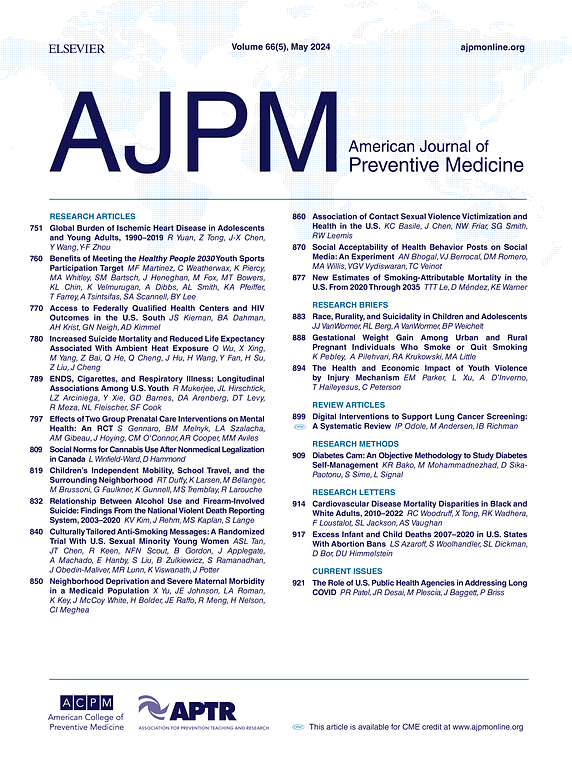2型糖尿病通过运动的种族差异:动脉粥样硬化的多种族研究。
IF 4.3
2区 医学
Q1 MEDICINE, GENERAL & INTERNAL
引用次数: 0
摘要
在美国,2型糖尿病(T2D)存在持续的种族和民族差异。少数种族和少数民族患糖尿病的风险更高,研究表明他们比白人锻炼得少。这项研究考察了T2D的种族差异是否可以用运动来解释,以及在多大程度上可以解释。方法:从多种族动脉粥样硬化研究(MESA)队列中纳入45-84岁基线(2000-2002年)无T2D的成年人,随访至2020年。采用多变量Cox比例风险回归检验种族与T2D的关系。通过自然中介效应评估运动解释的效应。分析于2023年进行。结果:在混杂因素控制下,西班牙裔[校正风险比(HR)(95%可信区间CI): 2.02(1.74-2.34)]、中国人[1.50(1.24-1.82)]和黑人[1.66(1.44-1.93)]的T2D风险高于白人。与白人受试者相比,西班牙裔[β (SE): -0.29 (0.04) MET-hour/day的平方根,P < 0.001]和中国人[-0.25 (0.04),P < 0.001]的习惯性有意识锻炼较低,而黑人受试者则不是这样[-0.01 (0.03),P = 0.85]。与白人受试者相比,习惯性有意识的运动解释了西班牙裔和中国人的T2D相对风险分别为13.6%和13.2%,但不能解释黑人受试者的T2D相对风险。结论:当将西班牙裔或华裔人群与白人人群进行比较时,习惯性有意识运动占T2D种族差异的十分之一。促进锻炼的干预措施对于降低所有种族人群的T2D风险至关重要,但也可能缩小西班牙裔和华裔人群在T2D方面的差异。本文章由计算机程序翻译,如有差异,请以英文原文为准。
Racial Disparities of Type 2 Diabetes Through Exercise: The Multi-Ethnic Study of Atherosclerosis
Introduction
Persistent racial and ethnic disparities exist for Type 2 diabetes in the U.S. Racial and ethnic minorities have a higher risk of Type 2 diabetes, and studies suggest that they engage in less exercise than White population. This study examined whether and to what degree racial differences in Type 2 diabetes were explained by exercise.
Methods
Adults aged 45–84 years without Type 2 diabetes at baseline (2000–2002) were included from the Multi-Ethnic Study of Atherosclerosis cohort and followed through 2020. Associations between race and Type 2 diabetes were examined using multivariable Cox proportional hazard regression. The effects of exercise were assessed using natural mediation effects. Analyses were conducted in 2023.
Results
Controlling for confounders, Hispanic (adjusted hazard ratio [95% CI]=2.02 [1.74, 2.34]), Chinese (1.50 [1.24, 1.82]), and Black (1.66 [1.44, 1.93]) participants had higher Type 2 diabetes risks than White participants. Hispanic (β [SE]= −0.29 [0.04] square root of MET-hour/day, p<0.001) and Chinese (−0.25 [0.04], p<0.001) participants had lower habitual intentional exercise than White participants; this was not true for Black participants (−0.01 [0.03], p=0.85). Habitual intentional exercise explained Type 2 diabetes excess risk by 13.6% for Hispanic and 13.2% for Chinese participants but not for Black participants, compared with that for White participants.
Conclusions
Habitual intentional exercise accounted for one tenth of the racial differences in Type 2 diabetes when comparing Hispanic or Chinese populations with White populations. Interventions promoting exercise are crucial to decrease Type 2 diabetes risk for all racial groups but may also narrow disparities in Type 2 diabetes among Hispanic and Chinese populations.
求助全文
通过发布文献求助,成功后即可免费获取论文全文。
去求助
来源期刊

American Journal of Preventive Medicine
医学-公共卫生、环境卫生与职业卫生
CiteScore
8.60
自引率
1.80%
发文量
395
审稿时长
32 days
期刊介绍:
The American Journal of Preventive Medicine is the official journal of the American College of Preventive Medicine and the Association for Prevention Teaching and Research. It publishes articles in the areas of prevention research, teaching, practice and policy. Original research is published on interventions aimed at the prevention of chronic and acute disease and the promotion of individual and community health.
Of particular emphasis are papers that address the primary and secondary prevention of important clinical, behavioral and public health issues such as injury and violence, infectious disease, women''s health, smoking, sedentary behaviors and physical activity, nutrition, diabetes, obesity, and substance use disorders. Papers also address educational initiatives aimed at improving the ability of health professionals to provide effective clinical prevention and public health services. Papers on health services research pertinent to prevention and public health are also published. The journal also publishes official policy statements from the two co-sponsoring organizations, review articles, media reviews, and editorials. Finally, the journal periodically publishes supplements and special theme issues devoted to areas of current interest to the prevention community.
 求助内容:
求助内容: 应助结果提醒方式:
应助结果提醒方式:


